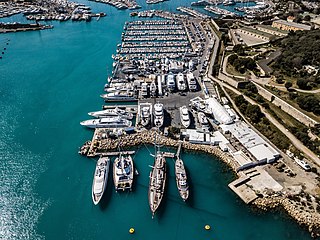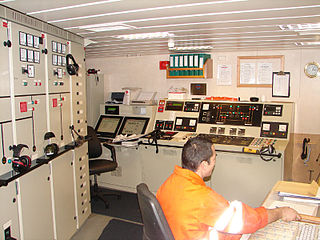Henry Adrian "Packy" Schade was a United States Navy officer, naval architect, and professor.

A shipyard, also called a dockyard or boatyard, is a place where ships are built and repaired. These can be yachts, military vessels, cruise liners or other cargo or passenger ships. Compared to shipyards, which are sometimes more involved with original construction, dockyards are sometimes more linked with maintenance and basing activities. The terms are routinely used interchangeably, in part because the evolution of dockyards and shipyards has often caused them to change or merge roles.
A midshipman is an officer of the lowest rank, in the Royal Navy, United States Navy, and many Commonwealth navies. Commonwealth countries which use the rank include Canada, Australia, Bangladesh, Namibia, New Zealand, South Africa, India, Pakistan, Singapore, Sri Lanka, and Kenya.

The Italian Navy is the navy of the Italian Republic. It is one of the four branches of Italian Armed Forces and was formed in 1946 from what remained of the Regia Marina after World War II. As of August 2014, the Italian Navy had a strength of 30,923 active personnel, with approximately 184 vessels in service, including minor auxiliary vessels. It is considered a multiregional and a blue-water navy.

Benjamin Franklin Isherwood was an engineering officer in the United States Navy during the early days of steam-powered warships. He served as a ship's engineer during the Mexican–American War, and after the war did experimental work with steam propulsion. Rising to the rank of rear admiral, as Engineer-in-Chief of the Navy during the Civil War, he helped to found the Navy's Bureau of Steam Engineering.
The Picatinny Arsenal is an American military research and manufacturing facility located on 6,400 acres (26 km2) of land in Jefferson and Rockaway Township in Morris County, New Jersey, United States, encompassing Picatinny Lake and Lake Denmark. The Arsenal is the headquarters of the US Army Combat Capabilities Development Command Armaments Center. It is known for developing the ubiquitous Picatinny rail, as well as being the Army's center of expertise for small arms cartridge ammunition.
Seafaring is a tradition that encompasses a variety of professions and ranks. Each of these roles carries unique responsibilities that are integral to the successful operation of a seafaring vessel. A ship's crew can generally be divided into four main categories: the deck department, the engineering department, the steward's department, and other. The reasoning behind this is that a ship's bridge, filled with sophisticated navigational equipment, requires skills differing from those used on deck operations – such as berthing, cargo and/or military devices – which in turn requires skills different from those used in a ship's engine room and propulsion, and so on.

Nikola Vaptsarov Naval Academy (NVNA) is the oldest technical educational institution in the Republic of Bulgaria. Its history, past and present achievements establish the institution as the most prestigious centre for training maritime specialists in the country. Its development over the years resembles a navigable river, into which many tributaries flow, as well as the "prototypes" of the present-day faculties, departments, and vocational colleges constituting the Nikola Vaptsarov Naval Academy.

An engineering officer or simply engineer, is a licensed mariner qualified and responsible for operating and maintaining the propulsion plants and support systems for a watercraft and its crew, passengers and cargo. Engineering officers are usually educated and qualified as engineering technicians.

Vice Admiral Baron Yuzuru Hiraga was a career naval officer in the Imperial Japanese Navy, Doctor of Engineering and head of the engineering school of Tokyo Imperial University and a leading Japanese naval architect in the 1910s and 1920s, responsible for designing a number of famous warships, many of which would later see action during World War II. He participated in establishing the Chiba Institute of Technology from 1941.

Admiral Samuel Murray Robinson was a United States Navy four-star admiral who directed Navy procurement during World War II.

The Royal Navy, commonly the Royal Yugoslav Navy, was the naval warfare service branch of the Kingdom of Yugoslavia. It was brought into existence in 1921, and initially consisted of a few former Austro-Hungarian Navy vessels surrendered at the conclusion of World War I and transferred to the new nation state under the terms of the Treaty of Saint-Germain-en-Laye. The only modern sea-going warships transferred to the new state were twelve steam-powered torpedo boats, although it did receive four capable river monitors for use on the Danube and other large rivers. Significant new acquisitions began in 1926 with a former German light cruiser, followed by the commissioning of two motor torpedo boats (MTBs) and a small submarine flotilla over the next few years. When the name of the state was changed to Yugoslavia in 1929, the name of its navy was changed to reflect this. In the late 1920s, several of the original vessels were discarded.
The United States Navy Nuclear Propulsion community consists of Naval Officers and Enlisted members who are specially trained to run and maintain the nuclear reactors that power the submarines and aircraft carriers of the United States Navy. Operating more than 80 nuclear-powered ships, the United States Navy is currently the largest naval force in the world.

Shinroku Momose was a Japanese aircraft/automotive engineer.
He is famous for the development of the Subaru 360, the Subaru Sambar and the Subaru 1000 series.

Charles Harding Loring was a U.S. Navy admiral and chief engineer.

The Surveyor of Buildings also known as the Department of the Surveyor of Buildings was the civil officer initially a member of the Navy Board then later the Board of Admiralty responsible for superintending, maintaining and improving the British Royal Navy Dockyards, Naval Buildings, and Architectural Works of the Admiralty from 1812 to 1837.

The Naval Works Department was the department of the Inspector-General of Naval Works, Brigadier-General Sir Samuel Bentham, who in 1796 had been given responsibility for modernising and mechanising the Royal Navy dockyards. The Department was established under the direct authority of the Board of Admiralty on 25 March 1796. In 1808 Bentham's job title was changed to Civil Architect and Engineer of the Navy, and he and his department were placed under the oversight of the Navy Board. In 1812 Bentham was dismissed and the department dissolved; most of its responsibilities were taken over by a new Department of the Surveyor of Buildings.

The Sea Transport Branch of the British Board of Trade, originally established as the Transport Department or Naval Transport Department, was a logistical branch of the Department of Admiralty responsible for the provision of naval transportation services. It underwent numerous name changes throughout its complicated history with responsibility for sea transportation, known as the Department of the Director of Transports from 1890.
École nationale supérieure maritime (ENSM) is the French National Maritime Academy, which trains merchant navy officers. It issues engineering degrees to Navigation Engineers who obtain the Merchant Navy Graduate Diploma (DESMM) and to students who follow courses in maritime engineering, majoring in ship eco-management (EGN) and deployment and maintenance of offshore systems (DMO).














